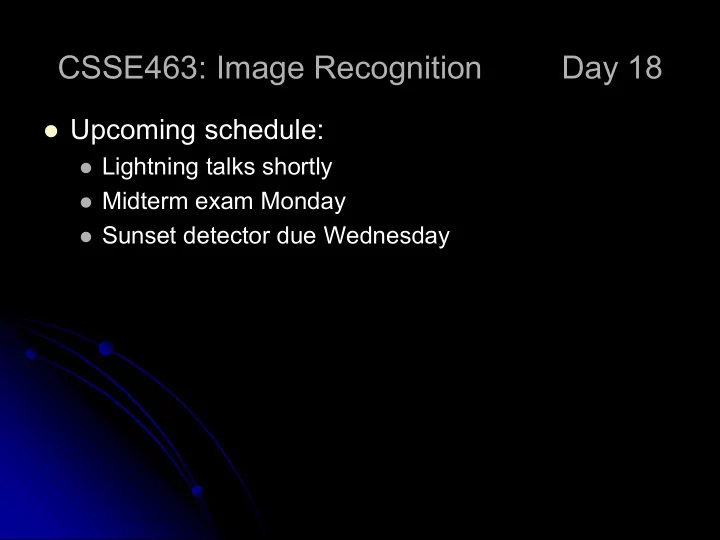

CSSE463: Image Recognition Day 18 Upcoming schedule: Lightning talks shortly Midterm exam Monday Sunset detector due Wednesday
Multilayer feedforward neural nets Many perceptrons Organized into layers x 1 y 1 Input (sensory) layer Hidden layer(s): 2 proven sufficient to model any arbitrary function x 2 y 2 Output (classification) layer x 3 y 3 Powerful! Calculates functions of input, maps to output layers Sensory Hidden Classification Example (HSV) (functions) (apple/orange/banana) Q4
XOR example 2 inputs 1 hidden layer of 5 neurons 1 output
Backpropagation algorithm Initialize all weights randomly For each labeled example: Calculate output using current x 1 y 1 network Update weights across network, from output to input, x 2 using Hebbian learning y 2 Iterate until convergence Epsilon decreases at every iteration x 3 y 3 Matlab does this for you. matlabNeuralNetDemo.m a. Calculate output (feedforward) R peat b. Update weights (feedback) Q5
Parameters Most networks are reasonably robust with respect to learning rate and how weights are initialized However, figuring out how to normalize your input determine the architecture of your net is a black art. You might need to experiment. One hint: Re-run network with different initial weights and different architectures, and test performance each time on a validation set. Pick best.
References This is just the tip of the iceberg! See: Sonka, pp. 404-407 Laurene Fausett. Fundamentals of Neural Networks . Prentice Hall, 1994. Approachable for beginner. C.M. Bishop. Neural Networks for Pattern Classification . Oxford University Press, 1995. Technical reference focused on the art of constructing networks (learning rate, # of hidden layers, etc.) Matlab neural net help
SVMs vs. Neural Nets SVM: Training can be expensive Training can take a long time with large data sets. Consider that you’ll want to experiment with parameters… But the classification runtime and space are O(sd) , where s is the number of support vectors, and d is the dimensionality of the feature vectors. In the worst case, s = size of whole training set (like nearest neighbor) But no worse than implementing a neural net with s perceptrons in the hidden layer. Empirically shown to have good generalizability even with relatively-small training sets and no domain knowledge. Neural networks: can tune architecture. Q3
How does svmfwd compute y1? y1 is just the weighted sum of contributions of individual support vectors: d = data dimension, e.g., 294, s = kernel width. bias numSupVecs 2 s ( 1 / d )* x sv y 1 svcoeff * e i i i 1 numSupVecs, svcoeff (alpha) and bias are learned during training. Note: looking at which of your training examples are support vectors can be revealing! (Keep in mind for sunset detector and term project) Much easier computation than training Could implement on a device without MATLAB ( e.g. , a smartphone) easily
Recommend
More recommend